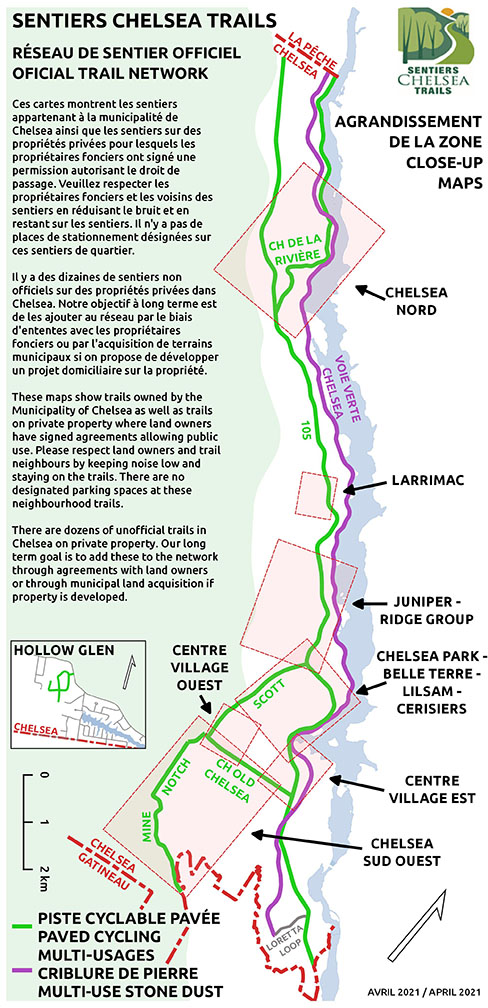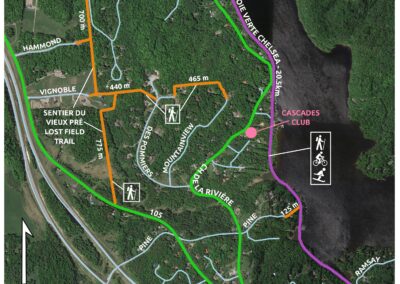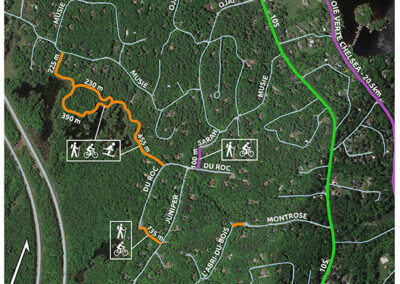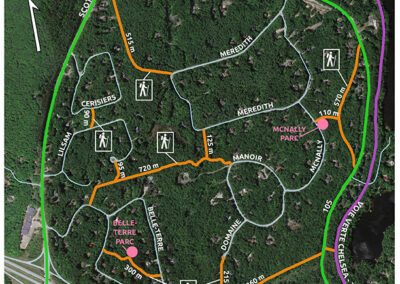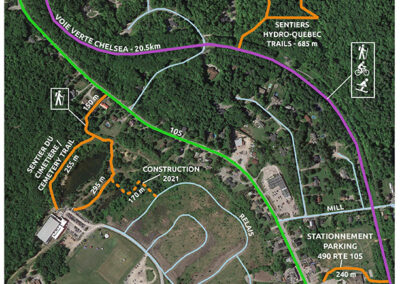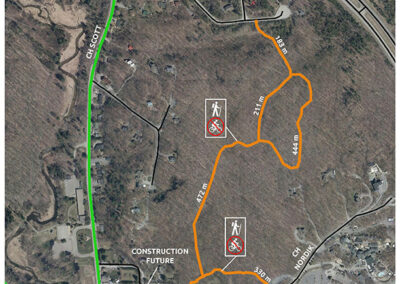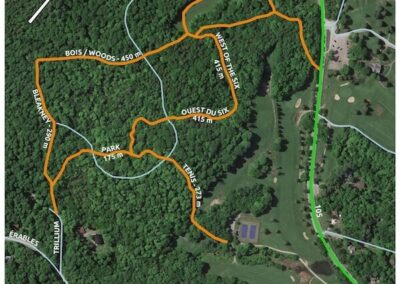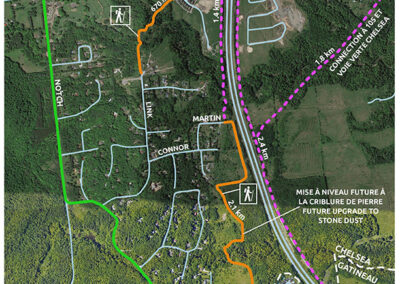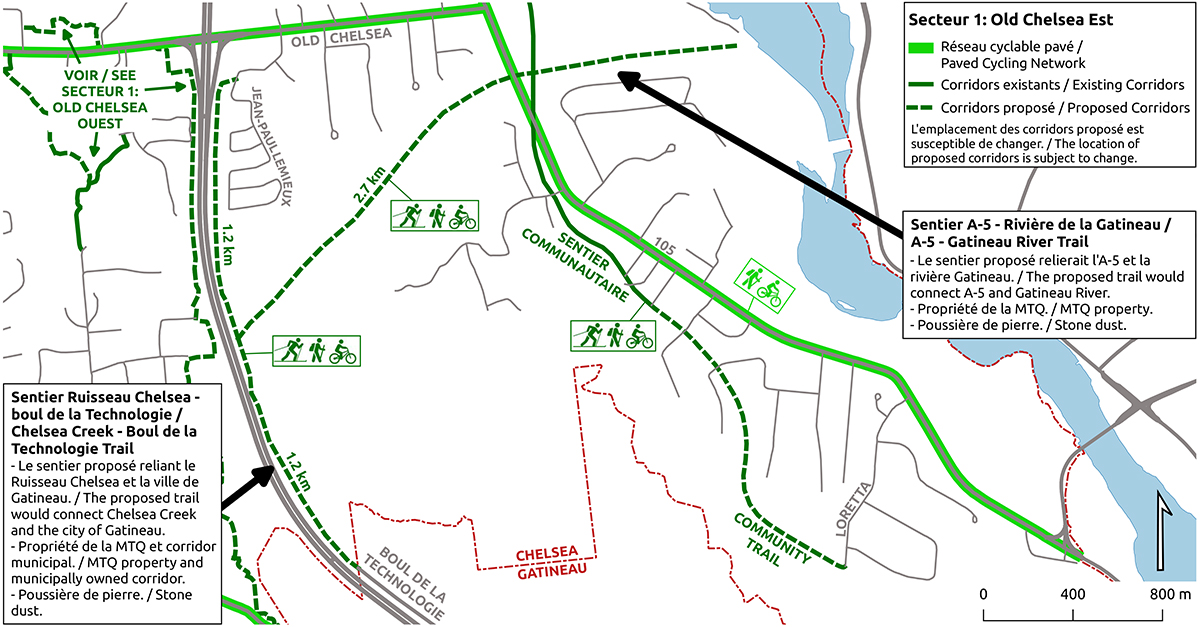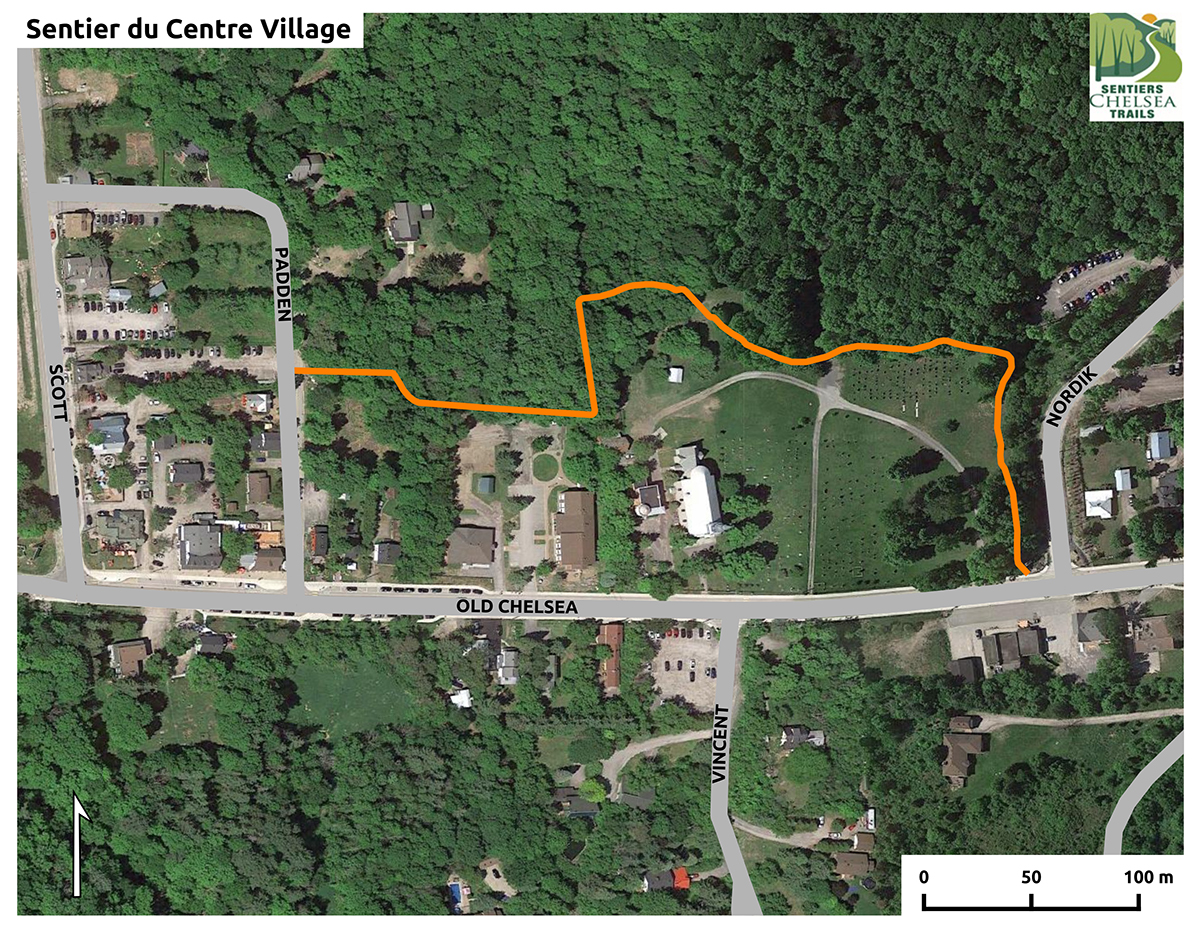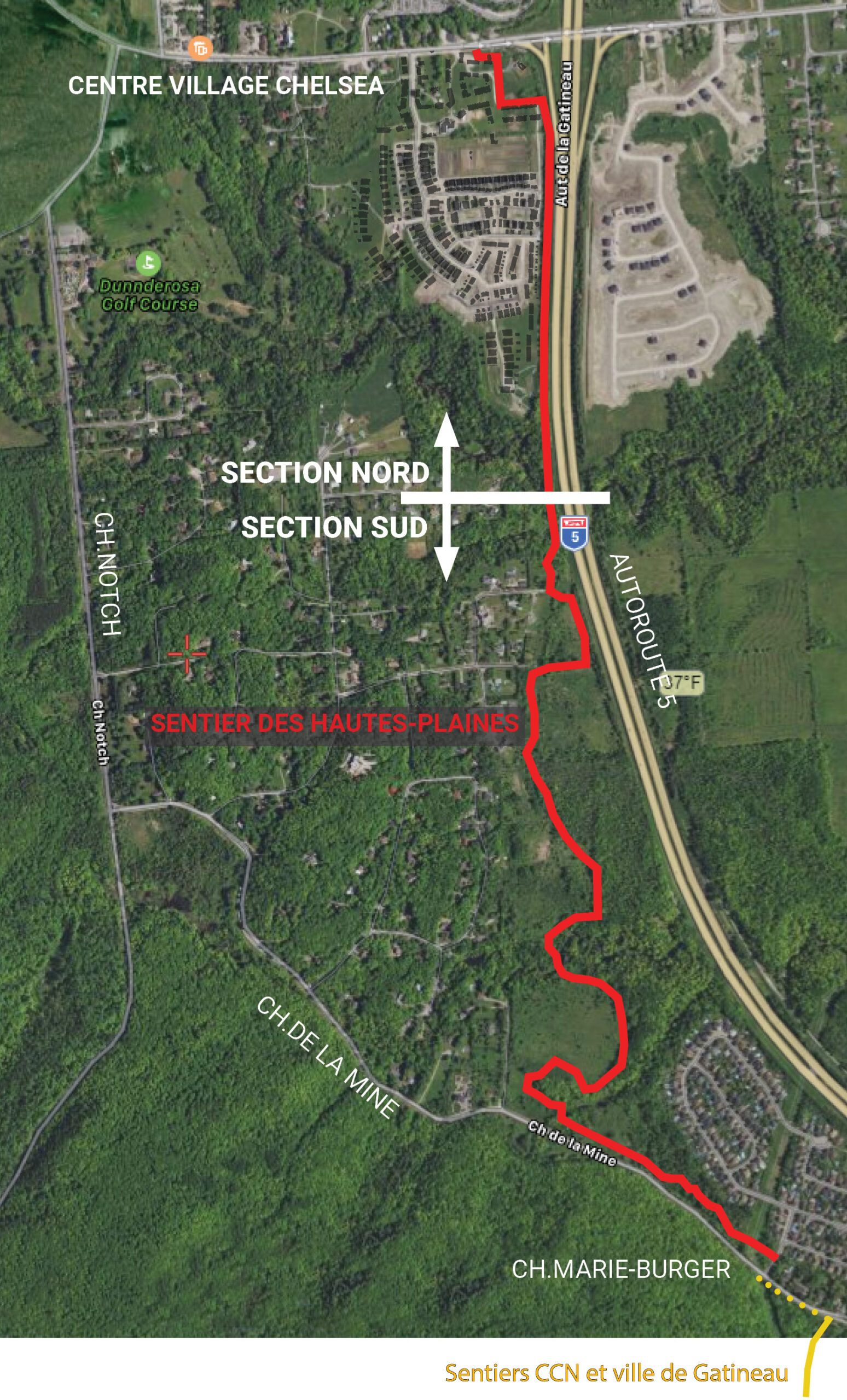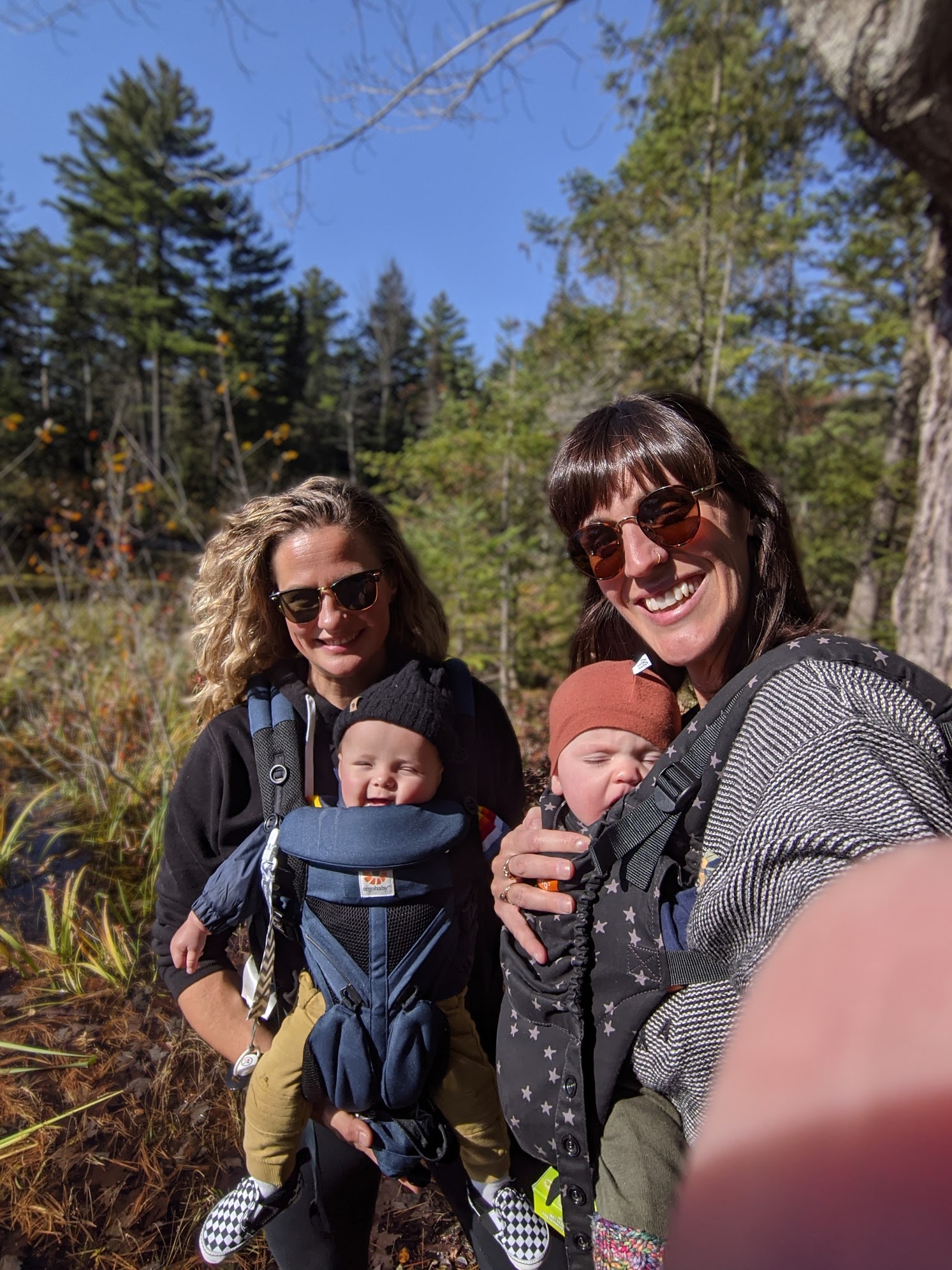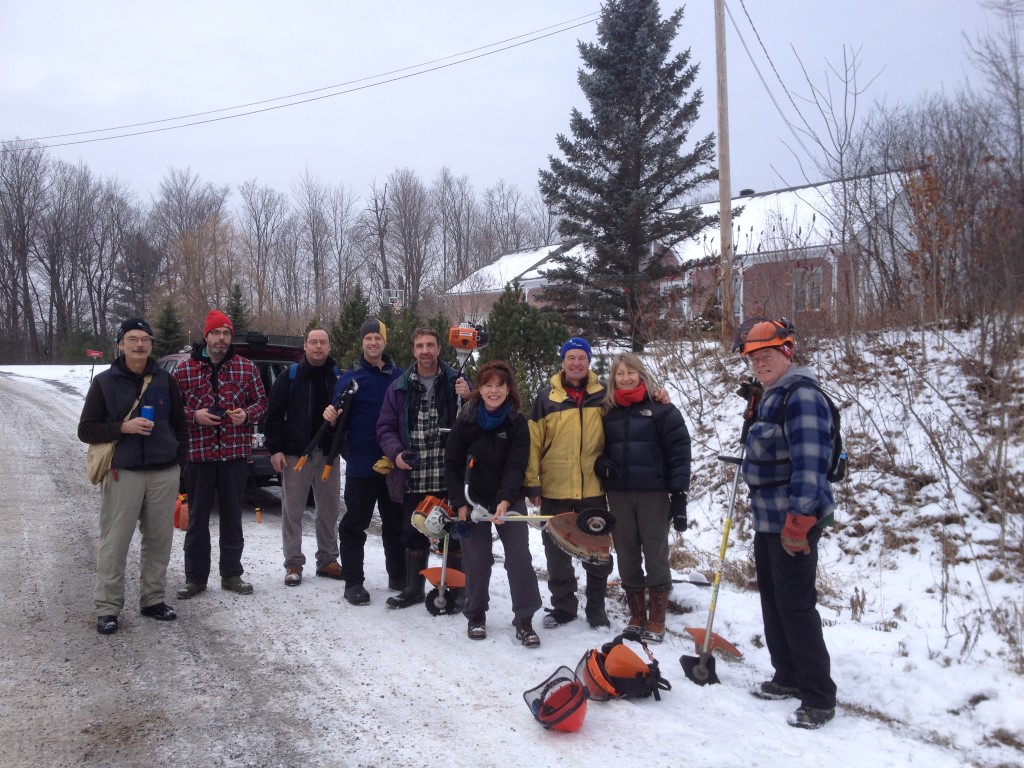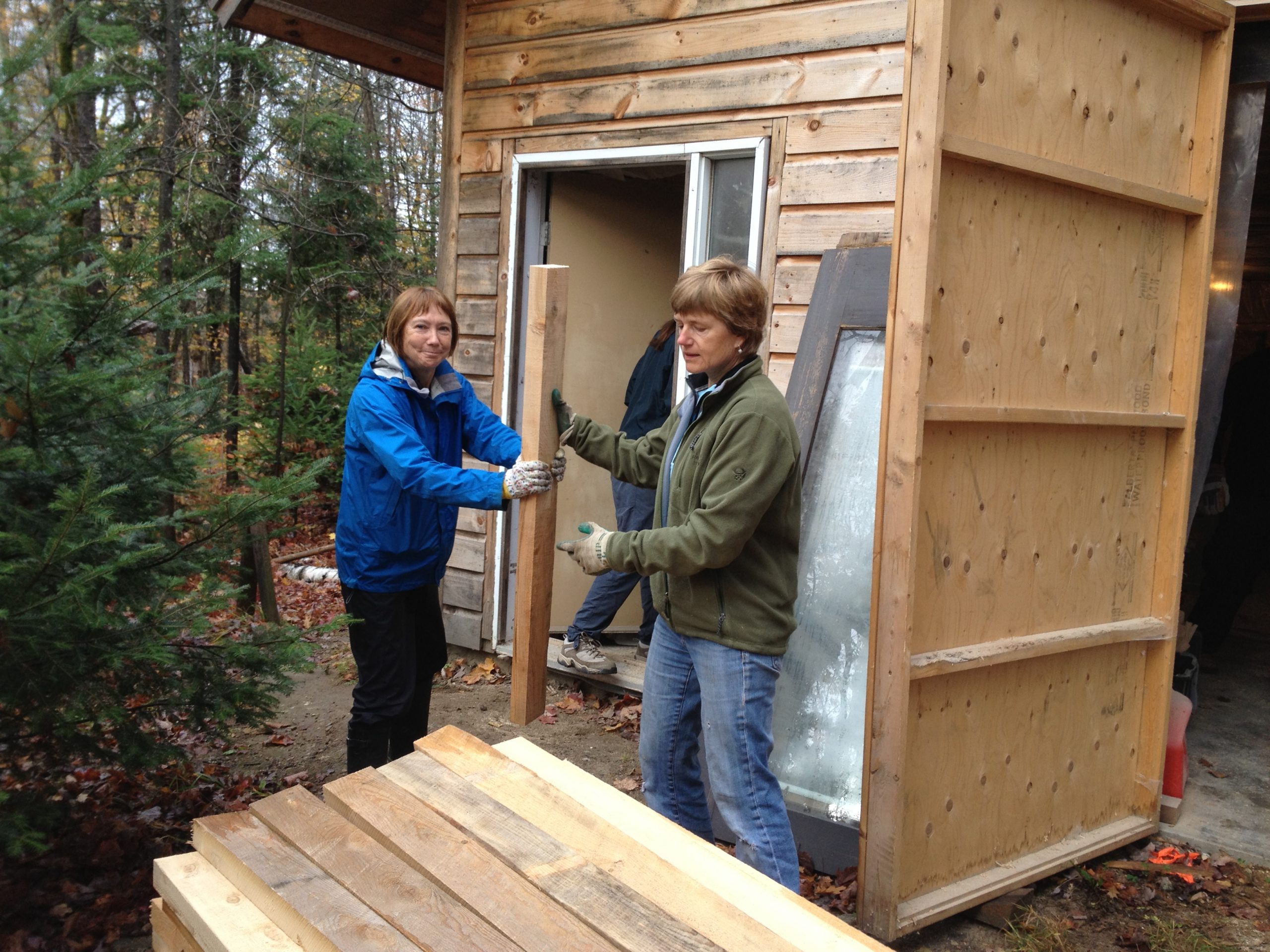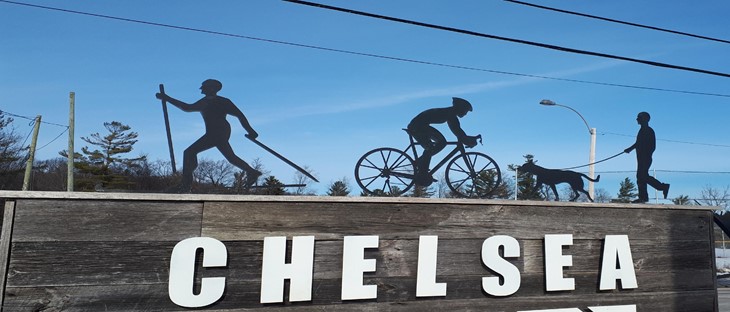Who We Are
For more than a hundred years, the culture of our village has been defined by the beauty of the landscape of the Gatineau hills and river. It is this treasured asset and the access to the natural worlds and recreation that continues to draw residents and visitors alike. SCT was founded by residents dedicated to finding ways to preserve what remains of Chelsea’s rich cultural and historical legacy of trails, and, where possible, to enhance and expand this existing trail system. Through these trails we promote active living, active transport and enjoyment of nature.
Through our trail building efforts and our partnership with the municipality, and other community groups, SCT works to give the trail network a strong voice in our community. We strive to:
- Advocate for the preservation of longstanding, informal community trail routes
- Improve active transport options for Chelsea residents and visitors
- Seek out opportunities to build Chelsea’s trail networks through new trail development
- Integrate trail considerations in the development and recreational planning processes at the Municipality
- Help turn the Municipality’s inventory of raw lands designated for trails into active trails
- Expand the network of trails in a sustainable and environmentally sensitive way.
The vibrant trails culture and trails networks we have in Chelsea could not exist without the dedication, energy and talents of our strong volunteer workforce. Hundreds of SCT volunteers have invested thousands of hours to map, build and maintain the trails we use. And we will continue to need volunteers to help with trail building and maintenance. If you are willing to lend a hand, or interested in allowing trails on your property, please get in touch!
Change is coming to Chelsea, with several new housing subdivisions breaking ground throughout the municipality. These developments will have a significant impact on the labyrinth of informal trails which have existed for generations. But they also provide opportunities to further extend the official trail network on land acquired by the municipality. The potential exists to create additional municipal trails to establish green links between more neighbourhoods to the centre-village.
Our Trail Network
These maps show trails owned by the Municipality of Chelsea as well as trails on private property where land owners have signed agreements allowing public use. Please respect land owners and trail neighbours by keeping noise low and staying on the trails. There are no designated parking spaces at these neighbourhood trails.
There are dozens of unofficial trails in Chelsea on private property. Our long term goal is to add these to the network through agreements with land owners or through municipal land acquisition if property is developed.
Projects
Chelsea Creek Bridge
This project will allow for the construction of a dedicated, multi-purpose pathway to provide an active transportation link between Chelsea’s centre village and Boulevard de la Technologie in Gatineau located a few kilometers south. The pathway, which will run along the right-of-way of Highway 5, will offer Chelsea residents new options for utilitarian and recreational use including a safe cycling connection to Gatineau and Ottawa. This modal shift could reduce greenhouse gas (GHG) emissions by a few thousand tonnes of carbon dioxide (CO2). In addition, approximately one hundred thousand dollars in expenses could be avoided by the citizens of Chelsea.
The portion of the pathway along the Chelsea Creek housing project is already built. Soon the firm Multivesco, the project promoter, will complete the connections of the neighbourhood pathways to the Chelsea Creek Pathway.
The main challenge will be the construction of a bridge across Chelsea Creek ravine. Thanks to a grant from the Federation of Canadian Municipalities’ Green Fund, Sentiers Chelsea Trails (SCT) and the municipality are currently working on feasibility studies that will hopefully be completed before February 1, 2021. The current schedule calls for completion of the second phase of studies, plans and specifications in 2021 and trail construction in 2022.
SCT would like to thank the developers of Chelsea Creek and Quartier Meredith for their financial support of this project.
Centre Village Trail Network
Hautes-Plaines Trail Upgrade
A new project is underway on the west side of Highway 5 to upgrade the Hautes-Plaines trail, connecting Chelsea’s centre-village to Gatineau city limits and the NCC trail network of Gatineau Park. Parts of this 3.8 km trail are well used but other parts, crossing difficult terrain, are in need of significant improvements to the surface and to the crossings over two ravines as well as over Chelsea Creek. Designated as a Structural Corridor (AS2) in the Active Transport Master Plan, this trail, when completed, will offer year-round recreational and active transport commuting opportunities for Chelsea residents and visitors alike.
For planning purposes, the trail is divided into North and South sections.
The undeveloped northern section runs along municipal land acquired for the trail during the Hendrick Farm subdivision process. It extends from Old Chelsea Road to Chelsea creek where it meets the southern section, which is made up of traditional trails on old farm roads and fields now belonging to Quebec’s Ministry of Transport. This southern section of the trail is 2.7 km long and ends at Chelsea’s southern border with the city of Gatineau, where it meets the vast National Capital Commission network of trails.
The short term priority for the Hautes-Plaines trail is to improve trail accessibility by building culverts over two ravines in the southern section. This project is being led by a very active local trails committee of residents from the neighbourhoods bordering the Hautes-Plaines trail.
Blog
Pandemic Babies on the Trail
My husband Geoff and I first started talking about moving to Chelsea after looking and looking for a home in Ottawa and realizing that maybe we wanted more than city living. Our friends Lydia and Felix have lived here for years and we would always come out for their...
Upcoming Events
Explore Chelsea with Sentiers Chelsea Trails –
Five free monthly events from July 19 to November 14*, 2025!
Sentiers Chelsea Trails invites you to explore Chelsea’s community trails during monthly events co-led by SCT board members and knowledgeable local experts.
From July through October 2025, SCT will host monthly two-hour themed hikes in different Chelsea neighbourhoods, where you can learn about the natural and cultural heritage of your community.
An evening celebration and presentation will be held at La Fab sur Mill Arts and Culture Centre on November 14, 2025.
Shorter and longer options will be offered for the hikes. Please wear footwear for hiking on uneven terrain and clothing appropriate for the weather. Check the SCT Facebook page the day before each event for possible rain dates.
Upcoming events:
Friday, November 14*, 19h to 21h evening event:
*NOTE CHANGE OF DATE
Join Sentiers Chelsea Trails Board of Directors, volunteers and friends for an evening of celebration and learn about the origins of Sentiers Chelsea Trails and la Voie Verte Chelsea. This event will take place at La Fab sur Mill Arts and Culture Centre.
*******
Previous Events:
Saturday, October 18, 9h45 to 12h00:
Curious about the geology of the Gatineau Hills? Join SCT for an informative hike with Dr. Robert Rainbird, Research Scientist at the Geological Survey of Canada, as we explore the Musie Ponds area and discover mica mines, quartzite, granite and the occasional erratic boulder! Meet at the Chemin du Roc Ouest cul-de-sac at 9h45. Hike begins at 10h00. Roadside parking is available. See SCT Facebook page for map details!
This hike is on uneven terrain with roots and rocks covered by autumn leaves; it’s recommended that you wear appropriate footwear and bring a hiking pole if necessary.
*******
September 27, 10 am – 12 pm:
Three local historians and SCT will co-host this walk, where you’re invited to explore the fascinating history and significance of Chelsea’s three cemeteries. This walk will begin at The General Store in the centre of the village. Parking is available in the village.
The guides will delve into the history of each cemetery, sharing information they have researched, which they have kindly offered to SCT to include on our website – please see below for the narrative texts describing each cemetery.
Visit of the Old Chelsea Protestant Burial Ground,
guided by André Renaud
Introduction
Not only is the protestant cemetery Chelsea’s oldest but also it is older than Chelsea. The first grave is dated 1835, so 40 years before Chelsea.
By using the protestant cemetery as a starting point, this tour allows us to glimpse at what life was like at the time and identify some grave stones to relate to the early settlers.
In 1801, Philemon Wright and his older brother Thomas came to the area from Woburn, Massachusetts. They qualified for a grant of the vacant Hull Township, a tract of nine by twelve miles, as investors committed to establish an agricultural community and develop the land. They came with mechanics, axemen and five families to establish an agricultural community.
In 1875, the city of Hull was created and the remainder of Hull township was divided. A portion was incorporated as the West part of the Township of Hull. It encompassed the area from Ironside to Farm Point as well as the other side of the Gatineau River. Eventually, Ironside became part of Gatineau; the east side became Cantley and the remainder of West-Hull changed its name to Chelsea in 1990.
Chelsea 1824-1875
In 1824, Thomas Brigham, Philemon Wright’s son-in-law, secured a grant for 600 acres adjacent to a 200-acre lot in Hull Township which had been reserved for a yet to be named future townsite. Brigham thought that his purchase would be a good development opportunity being next to the future town. He named the area Chelsea after his hometown in Vermont. However, as it happens, development had not waited to occur outside the reserved townsite and the 200-acre vacant lot was finally sold in 1835. Brigham was able to purchase half the site which was no longer needed. It included the cemetery and he allowed it to continue.
Development was sufficiently advanced that Brigham saw a need and built a sawmill and grist mill to serve the growing community. In the 1830s, the Old Chelsea Road was a dirt road, named High Street. It passed right-by the edge of the cemetery, which was probably bordered by a split rail fence, and led to Chelsea Brook or Creek where Brigham operated his mills. A few years after 1835, the High Street was angled north which created space between High Street and the new road – today’s Old Chelsea Road. The added space was used for building lots where, for example, sits the Dunn Hotel, the green building on the right, as we pass the gates. The 1891 date on the gates likely indicates the year when they were installed.
By 1875, one hundred and fifty years ago, in addition to the sawmill and grist mill, the village had a number of services including a post office, a general store, four hotels, a blacksmith, the St. Stephen Church (at the time a wooden structure), a tannery, a shoe maker and a shingle mill. Chelsea had expanded to what was then known as “New Chelsea” and several houses and services were built along highway 11/105. Indications are that the population of the new municipality was at least 3,000 persons in 1875.
West Hull council’s first meeting was at the O’Neil Hotel built in the 1850’s, number 577 on Highway 105, south of the entrance to the Pioneer Cemetery. Arthur O’Neil had the place painted red, with a sign indicating that it was a temperance hotel with stabling for horses. Ten diners could be accommodated at the long table. Such hotels, whether dry or wet, were used amongst others by teamsters to stable their horses on their journeys.
Old Chelsea Protestant Burial Ground
Today we designate the cemetery as the Old Chelsea Protestant Burial Ground (OCPBG). It is owned and managed by the municipality of Chelsea and listed as an Historical monument which is closed to further burials
There are 54 stones in the old section and nearly half of the families with monuments were in Chelsea in the 1820s and 75% had arrived by 1842, years before West Hull was incorporated. The 14 stones in the Annex refer to more recent burials. All told, there are 104 persons named on the stones. However, it is estimated that there are more or less 200 burials in the cemetery as various records identify an additional 78 persons buried with no grave marker. These include Phillip Leppard, ( 1842-1925) a blacksmith whose forge was just west of the St. Stephen parking lot and who may well have been the one responsible for the gates.
The persons buried in the first few decades came from all sectors of the West Hull community, including areas that are now part of Cantley or Gatineau. As there was no cemetery attached to the existing protestant churches, the religious denominations of those buried were also diverse. They were: Anglicans, Presbyterians, Methodist, Baptist, Plymouth Brethren, Catholic Apostolic, and others no longer heard of.
Some of these earlier arrivals were connected to Hull Township’s founding Wright family, by personal or business relationships, or both. Others, simply arrived and took up available farm land or found other work. By the end of the mid 1850’s, Gilmour Mills attracted workers from other Canadian settlements and abroad and some of these families used this cemetery.
Cemetery Tour
You will have noted that some stones have been flagged and you are invited to visit them with the help of the information below. But first, let us look at the bench and plaque honouring Carol Matin. She was a dedicated citizen of Chelsea who wrote a master’s thesis on Chelsea’s Historic Cemeteries and whom I relied on for the suggested tour. Her thesis was summarized in a book which you can borrow from the Chelsea library or purchase from the Gatineau Valley Historical Society.
West Section
Wilson The Wilson family arrived in Cabada in 1842.here are four stones. Andrew Wilson tried his hand at various enterprises, including Old Chelsea’s first powered loom before turning to printing. He published the weekly Banner, which later became the Daily News, Ottawa’s first daily newspaper.
Asa Meech for whom Meech Lake is named. The reverend Asa Meech was well loved and respected by the people to whom he ministered as pastor, teacher and doctor. His farm was at the east end of Meech Lake. His house is situated off the road in a small grove of trees and is maintained by the NCC.
William Chamberlain The stone of this eight-year-old does not name his parents. With his monument’s1835 date it is the second oldest in the cemetery.
Reid-Chamberlin (Two monuments) James Reid and Cynthia Chamberlin, a young married couple who died within months of each other and remembered by the telling lines on the stone.
|
For James who died in February 1857 |
For Cynthia who died in October 1857 |
|
Our wasting lives grow shorter still As months and days increase And ev’ry beating pulse we tell Leaves but the number less |
As daughter sister mother wife But few have equalled none surpassed Her faithful constancy through life Her strong affection to the last |
Thomas Wright This is the earliest-dated grave monument in the NCR, commemorating this founder of Hull Township. At the time when Wrighville in Hull Township was just beginning, the grave stone was probably made in Vermont and subsequently installed after 1835.
East Section
Childs The gate of the Childs Plot inscribed ‘Mather 1870”, marks the entrance to a “recycled plot”, used by the Childs family after the Mather family transferred Annie Mather’s remains to a city cemetery.
Schalm William R” Schalm has the only military marker in this cemetery, and the headstone for his plot announces that he was a “home boy”, a child worker sent from an English orphanage to Canada.
Kirk Note the stone for Lydia A. Kirk to admire this Victorian tablet with a dove and olive-branch motif and its heartfelt epitaph for a 16-year-old.
South Annex
Crawley Note the Crawley Film logo for Judy and Budge Crawley famous Canadian film makers.
Spry Note the detailed inscription for the social activist and businessman Graham Spry.
The world is a better place because he lived in it”
He was a city resident who spent his summers at a cottage in Kingsmores. He was a activist and businessman. His stone describes his education.
Heisel Note the Scandinavian style stone for Fritze Heisel.
Landmarks
The Dunn Hotel, previously mentioned, was originally built as a private residence before being transformed into a hotel in the mid-1800s. The original structure was rebuilt in 1901. It was later converted into apartments and remains in that form today.
Across the street, corner of Padden and Old Chelsea roads, the Chelsea Pub is where the old Dean Hotel The West Hull Council held several meetings there in 1875 before building a town hall next door the following year. The hotel business was closed when prohibition was declared in 1893. See below at corner of Paden Road next to first Town Hall. See picture below which includes the Dean Hotel on the rightot the Town Hall. (Photos not currently available on SCT website.)
The Town Hall was built where the Chelsea Pub’s patio is located.
The Sweeney Hotel was located where the Boulangerie du Village is located and where T.B. Prentiss (the T. B. stands for Thomas Brigham) operated his general store and post office in 1834.
Along the Padden Road as we leave for the St, Stephen cemetery, we can see on the left, number 9, the Brigham-Chamberlin House which is the oldest house in the village. Due to road enlargement, it was moved in 1962 from the original farm nearby. It is believed that the house had been constructed in 1850, so 175 years ago. It stood adjacent to the barn that still stands across the corner of Kingsmere and Old Chelsea roads. The photos below show the house before and after it was moved as well as the barn. (Photos not currently available on SCT website.)
Recent History
The municipality has received a donation of $ 260,000 in June 2020 from Ms. Janet Benedict for the historical cemetery. One set of her great grandparents are buried in the cemetery – Philip Leppard (1832-1909) previously mentioned and Mary Anne Bradley.
|
Sources: In Memory of Chelsea’s Historic Monuments, Carol Martin, Castenchel Editon, 2005 Touring the Chelseas, R.A.J. Phillip, The Historical Society of the Gatineau, 1991 A Tale of Two Chelseas, P.M.O. Evans, es Éditions J, Oscar Lemieux Publisher Inc., Contributors to the UTG in volumes number:1, 2, 4, 11 13, 14, 17, 27, 26, 34, 43 and 47. Photos: A scrapbook of Old Houses by Heather Quipp, 1975, Original document in PDF format, GVHS, Places, Towns, Villages and Municipalities, Old Chelsea.
|
Visit of St. Stephen’s Roman Catholic Cemetery,
guided by Suzanne Gibeault
• On June 2, 1841, Thomas Brigham, son-in-law of Philemon Wright, donated some land to the Mission church of St-Étienne. Subsequently a transaction between the Parish and Christopher Columbus Brigham saw the Parish acquiring more land through a land sale in October. 9, 1902.
• October 15, 1845, the mission church of Saint-Étienne de Chelsea was consecrated as St. Stephen’s Roman Catholic Parish under the Diocese of Ottawa.
• In December 1845, Father James Elias Hughes (from Ireland) was appointed the first Parish priest and on that date opened the parish registers. Father Hughes is buried under the church. (See photo) (Photos currently not available on SCT website.)
• The mission church was replaced by the large stone church which began construction in 1879 and completed in 1882.
• In 2025, St. Stephen’s is celebrating it’s 180th anniversary as a Parish. The Cemetery is administered by the Parish and is an open or active cemetery measuring about 3 acres of which 2.5 acres can be used for interments. Today there are approximately 2000 or more burials in the cemetery.
• The cemetery is divided into 4 sections with the potential for a future columbarium.
• The Parish register’s first entry is the baptism of Annie Blake on December 6, 1845. Later she is also shown in the registry as being buried in January 1874. Her husband, Edward Dean, outlived his wife by 24 years and was a businessman running the Dean Hotel, now known as the Chelsea Pub.
• The second entry in the register is the burial of Jane Crolly on December 15th, 1845. It is possible that her last name is a misspelling and should actually be “Crilly” – as there are many Crillys buried in the cemetery. Cemeteries often have family names with different spellings i.e., Walsh/Welsh/Welch.
• The presence of Irish Catholic immigrants is seen throughout the cemetery mainly in the section closest to the church. Look for Celtic crosses, shamrocks etc. and the names of the Irish counties of origin on the weather-worn tombstones.
• Two such separate tombstones, a husband and wife, Thomas Padden (D.1887) and Bridget Scott (D.1891) both from Callan Country of Kilkenny, Ireland share their names with two roads in the village.
Note some of the names of the earliest founding families over the Parish’s 180 years: Corrigan, Dunn, Daly/Daley, Fleming, Dunlap/Dunlop, Dufour, Hendrick, Kelly, Mulvihill, Murphy, O’Neil, Padden, Ryan, and Scott, Trudeau, Walsh/Welsh/Welch, and the Youngs.
There are also burials of those who served in the military noting special grave markers such as Charles William Boland, former owner of the M&R Dépanneur who died in 1963.
The Chelsea Community Back in the Day (Social and economic activity)
Timber and lumbering as well as farming were the mainstays of the economy for the greater part of the 19th century. Secondary industries included mining and the production of potash. The establishment of sawmills provided materials for construction (shelter for humans and farm animals) and nails and spikes made by local blacksmith. Farming was very important economically in support of timbering and lumbering in a number of ways and men on farms turned to the timber trade during the winter months. Limited cash was in circulation in the early days and a system of bartering prevailed. Hotels/taverns, stores, a post office and a tannery also supported the settlers in and around this time.
Other religious denominations had small churches and served Methodist, United, and Presbyterian followers. Only three churches in Chelsea remain, St. Mary Magdalene Anglican Church, Grace United (now La Fab), and St. Stephen’s Catholic church with adjoining cemetery.
Sources: Ancestry, Newspapers.com, In Memory of Chelsea’s Historic Cemeteries (C. Martin), A Tale of Two Chelsea (P. Evans), Drouin Records, Touring the Two Chelseas (RAJ Phillips), GVHS Up the Gatineau volumes, St. Stephen’s Roman Catholic Cemetery (P. Evans & B. Elliott for the Ontario Genealogical Society 1979).
Visit of the Chelsea Pioneer Cemetery and Cenotaph,
guided by Marc Cockburn
Year the cemetery was established / year it was used for its intended purpose
– Fourteen gravestones record the deaths of 31 persons between 1837 and 1962.
– At least 67 persons were once laid to rest in this small space. Most of these other graves were probably never marked, although three bases remain in plots from which the monuments were removed. Twelve persons originally buried here were later transferred to other cemeteries.
– The burial area measures about 100 by 200 feet, now expanded within a 156 by 234-foot enclosure, described in municipal records as part of Lot 11, Range 9.
– The full 200-acre lot was first awarded to John Maxwell, who had settled on the land in 1825 and received title to it on September 21, 1827.
– A father and son, Jared and Gardner Church, Americans from Campton, New Hampshire, took up lots on either side of Maxwell’s at the same time as he did, and the Church family obtained his lot as well after Maxwell moved to Wakefield Township (on Rockhurst).
– Church family owned approx. 600acres to the Gatineau River.
– The Church family donated land for a Presbyterian church building, which was erected in 1858. By the 1870s, three Protestant churches had located in the newer Chelsea, while the Roman Catholic church was in Old Chelsea.
– Wesleyan Methodist and Anglican churches and their rectories were near the Presbyterian church, so that a stretch of road (now Route 105) at the north end of Chelsea village became known as “gospel hill.”
– None of the Protestant churches had churchyard cemeteries. The Protestant community cemetery (Old Chelsea Protestant Burial Ground) was already established at nearby Old Chelsea.
– Land was eventually passed on to Cecile Meredith (Great-grandson of Gardner Church)
The Chelsea community at that time (ca 1850-75)
– In 1841, brothers Nathaniel and Julius Blasdell built a sawmill on Chelsea Island. Their operations at the site would eventually lead to the end of the “Gatineau Privilege” whose participants had enjoyed a virtual monopoly on the Gatineau River since 1833.
– The Blasdell brothers were supported by a new firm, Gilmour and Company, Scottish shipbuilders who had recently entered the lucrative Quebec timber market.
– By 1848, however, the Blasdells were deeply in debt to the Gilmours, who then took over the mill operations on the Island.
– The 1840s and 1850s were significant decades for the sector of Chelsea near the Gatineau Falls, where the Church family property bordered the Gatineau River. A sawmill on the river at Chelsea Island began attracting workers after 1845, so that by the late 1850s Gilmour’s Mills was prospering.
– As well as providing employment for local farmers’ sons, the sawmill attracted workers from outside Chelsea, and other small businesses began to establish themselves in a village core in this “newer” Chelsea. This new Chelsea village was just about a mile to the east of Old Chelsea.
Gilmour Mills ca. 1871
– Chelsea Island workers and inhabitants. By the end of the 1800s, the Gilmour’s’ mills (the Gatineau Mills), comprised a busy industrial site with a log slide to piling grounds at Ironside and small cottages for workers living too far away to commute.
– Total of 250 people living on Chelsea Island – 75 families: 50 laborers and mill hands; 20 tradesmen – Millwright, carpenters, blacksmith; 20 Clerks and bookkeepers, managers, agents, and cullers.
– Another 80 or so in Chelsea Village: Was on the Gatineau Road, 3 general stores, a post office, 3 hotels and taverns, 3 churches, masonic lodge, blacksmith, and shoemakers.
– The Panic of 1873, a financial crisis that affected North America severely, kicked off a depression that continued for the remainder of the decade, forcing Gilmour and Company to end operations in 1891.
– Sawmill closed and most workers left, however became a summer retreat for many of the workers – 1926 dam construction started, and the summer residents moved to Tenaga.
Recent history
– Private Richard R. Thompson of the Royal Canadian Regiment (and a medic) as a recipient of one of four scarves made by the Queen Victoria). Kenneth Richardson, 1960’s locating the scarf with a Thompson descendant in Ireland and the grave in this Chelsea cemetery. The original Scarfe is now on display at the War Museum.
– Doug Cowden, a nephew of Thompson’s wife (Bertha Alexander) identified the grave and volunteered to work on cleanup and marking of the site.
– Local residents founded the Historical Society of the Gatineau in the summer of 1962 (Moorside Tea Room). The cemetery site by then belonged to Cecil Meredith, a Church descendant, who was willing to provide land comprising the burial site along with a new right-of-way as access and some additional space for parking, all for $1000.
– The Society would have to become legally incorporated to manage the cemetery. Accordingly, the Historical Society of the Gatineau received its letters patent on July 8, 1965, and purchased the cemetery site on December 19, 1966.
– First Chelsea Cenotaph erected in 1968.
– A re-dedication ceremony held on May 24, 1986, involved participation of troops from the Royal Canadian Regiment (Petawawa Battle School) and officers from the Canadian Forces Medical Services.
– Since 1986, the Historical Society organized a Remembrance Day ceremony at the cemetery in that year and afterward continued with an annual recognition of Private Thompson and participation of troops each November 11 at the cemetery. (Bob Phillips)
– In April 1989 the Municipality passed bylaws declaring both the Chelsea Pioneer Cemetery and the Old Chelsea Protestant Burial Ground to be historical sites.
– On November 11, 2001, a memorial plaque with the names and details of nine men from Chelsea who lost their lives in World Wars I and II was dedicated at Chelsea’s Pioneer Cemetery – Allen Richens.
– Renovated in in 2016 (Carol Martin bequeath) and transferred to Chelsea Municipality in October 2017.
Cemetery walk through
1 – RICHARD R. THOMPSON,1908
Thompson was born in Cork, Ireland and came to Canada some time after 1897; he enlisted with the 2nd Special Service Battalion of the Royal Canadian Regiment in Ottawa on October 18, 1899. We know that on at least two occasions he risked his life under enemy fire to try and save fellow-soldiers. At Paardeberg he stayed on the battlefield with a man who had been shot in the throat, pressing bandages to the wound to prevent bleeding. A few days later he tried to rescue a wounded man on the battlefield, although this time his efforts came too late to save the man.
He was invalided back to Canada by the end of July 1900, and after a short career in South Africa and the United States, he died of appendicitis in a hospital in Buffalo, New York in April, 1908. His military funeral was held April 8th in the Drill Hall on Cartier Square in Ottawa, after which his body was sent by the Gatineau train to Chelsea.
2 – ALEXANDER, JAMES (1903), MARY GRAHAM (Wife) (1906), BERTHA ALEXANDER (WIFE OF THOMPSON), 1962
The Alexander stone, next to Private Thompson’s, is for James Alexander, his wife, Mary Graham, and their daughter Bertha. James, a lumberman, was only 58 when he died on September 5, 1903, and Mary was 54 years and 4 months old when she died on October 19, 1906. The family residence was at Meech Lake, where they had lived for about a decade, having arrived in the 1890s.
Bertha Alexander probably lived in Chelsea for a few years in the 1890s when she was in her late teens, but by the time she was twenty, Bertha left for South Africa on May 25, 1904, to get married to Richard Rowland Thompson, and following their marriage the couple lived for a time in South Africa and then arrived in New York State. After Thompson’s sudden death in 1908, Bertha remarried and was again a widow by 1926. From the 1920s on, Bertha Alexander lived in Farmingdale, New York, and worked for many years as a nurse in nearby Amityville. Her death in 1962 came as efforts were being made to recognize Private Thompson and his burial site. Her ashes were interred in the plot with Thompson and her parents, the only burial in this cemetery after the first decades of the century. Relatives provided a monument at that time for Bertha Alexander and her parents. Andrew Alexander, Bertha’s brother, is buried in the South Annex of the Old Chelsea Protestant Burial Ground, along with several members of his family.
3 – SARAH MOORE (DAVIES), 1903
Sarah Moore was born in Ireland, and may have been a sister or cousin of Thomas Moore, an Irish Presbyterian hotel keeper whose establishment was located near the cemetery. This would explain her burial in a Chelsea cemetery, since she and her husband, Thomas A. Davies, a carpenter who had come out from Wales, were living in New Edinburgh at the time of her death.
4 – JAMES HUDSON (1891)
James Hudson (4) was the 21-year-old son of William and Ellen (Eliza) Hudson, who had a farm at Ironside. Newspaper accounts describe how he and his 6 six-year-old sister Maud were burned to death in May 1891, in a house fire from which other members of the family escaped. Members of the Hudson family arrived in Chelsea in the 1820s from Newport, Quebec, where they had lived for at least two decades after moving from the United States. Earlier generations of this family are buried in the Old Chelsea Protestant Burial Ground. The Hudson family was also related to the Churches, which may have encouraged them to use this cemetery once it had expanded beyond a plot for immediate family.
5 – CHRISTOPHER C. WRIGHT (1906) HANNAH LATIMER (Wife) (1915), BESSIE LILLIAN (daughter) (1912)
Christopher Columbus Wright is a descendant of the Wrights who founded Hull. Christopher C. farmed Lot 8, Range 4, near the village of Ironside in Chelsea; his father, also a Christopher Columbus, was a son of Philemon Wright. He is buried with his wife and a granddaughter. They attended the Anglican church in Chelsea.
6 – THOMAS EVANS (1908)
Thomas Evans was a devout Baptist who worked as a clerk in Charles Dewar’s Chelsea store. Thomas Evans died at the home of his friend and employer, Mr. Charles A. Dewar. Early in the twentieth century, Dewar was the main merchant in Chelsea. The Dewar enterprise had been a presence in Chelsea since the 1870s. The building burned early in the twentieth century and was rebuilt, but the ambiance could not be duplicated.
7 – MARGARET WILLIAMS (Wife of William Montgomery) (1893)
The death of Margaret Williams, wife of William Montgomery, is recorded on a stone whose base is inscribed with the Dunn family name. Two Dunn families in Chelsea, one Protestant and the other Roman Catholic, both kept hotels. Although she was related to the Dunn’s, she remarried William Montgomery. they lived in New Edinburgh, then a village on Ottawa’s outskirts, and in Ottawa. William was variously occupied as a carter, labourer, driver and teamster. Margaret died suddenly, aged 70, at 54 King Street, Ottawa, and was interred “at Chelsea” on August 16, 1893. Her family connection with the Dunns and with Chelsea is evident, although the monument does not explain further.
8 – HATTIE STOTHERS (McLATCHIE) (1894) JAMES LESLIE (SON), 1892
Hattie and James Stothers (8), young adults buried here, are brother and sister. Their parents, James Stothers and Harriet Kellogg, variously ran a hotel and a meat business in Chelsea. The senior James died in 1898 and was also buried in this cemetery, probably in the same plot as his children, although he has no marker.
9 – JOHN D. MEECH (1901), STEVEN H. (Son – Drowned, 26 YS) 1839, SILAS A. (Son – Drowned 24 YS) (1839), WILFORD A. (Son DIED at 2yrs), 1875
The four members of the Meech family buried here are a son and grandsons of Asa and Margaret (Docksteader) Meech, whose graves are in the Old Chelsea Protestant Burial Ground. John D. Meech married Mary Church, a daughter of Gardner Church, senior. Steven and Silas drowned in a canoe accident, in the lake named for their grandfather. The tragedy was baffling, as the lake was calm at the time and both young men were expert swimmers. The Daily Citizen reporter theorized that their feet may have been caught by the thwarts of the canoe. A half century earlier Asa Meech’s second wife had also died by drowning, along with several of John’s half-brothers and sisters.
10 – JARED CHURCH (1852), HANNAH BARTLETT (Wife) (1864) GARDNER CHURCH Sr. (1882) MARTHA CONE (WIFE) (1876 ), WM. CHURCH (son 9 YRS) (1851) HANNAH B. (DAUT. OF G. & M. CHURCH) (1854), GARDNER CHURCH Jr (l904)
The names of Jared and his son Gardner Church can be found among the 206 heads of The Church family stone marks the burial place of both father and son, their wives, and three grandchildren.
Three children of Gardner and Martha Church, including Gardner, junior, are also named on the family stone. Two other sons, Selden and Horace, were once buried here. In 1924 their remains, along with those of Horace’s wife and two infant children, were moved to Beechwood Cemetery. The houses of these three brothers are still standing, located on Route 105 just south of the cemetery.
11 – JOHN CHAMBERLIN 1837, MARY BLOSS (WIFE) 1889
Like the Churches, John Chamberlin and his wife were Americans who came to Chelsea in the 1820s. Their land adjoined that of the Churches, and their daughter Sophia’s marriage to the junior Gardner Church provided another link to the family. Anson A. Gard, a late nineteenth-century journalist who wrote about local families, mentions that John Chamberlin drowned in 1837 at “the Cascades,” rapids on the Gatineau River. Mary outlived her husband by more than 50 years and, according to family legend, aspired to reach 100; the dates on her stone show that she was within five months of that goal.
12 – MINNIE Church WIFE OF JOHN K. MEREDITH (1889) ,LITTLE MAY (DAUGHTER 3 yrs.) 1895
The Merediths buried here are a daughter and granddaughter of Gardner Church, junior, adding two more generations (for a total of five) for this family in the same cemetery. Little May Meredith died in “South Indian,” Ontario, now Limoges.
13 – JOHN A. CAMERON (1890), DUNCAN CAMERON (1857)
John Alexander Cameron’s monument makes no mention of the unusual accident that caused his death: he was struck by lightning. According to the (Ottawa) Daily Citizen, he had been returning home between 6 and 7 o’clock in the evening on Tuesday, June 24, 1890, driving a load of stone on a wagon. A violent storm began, and “the most serious disaster recorded is the death of Mr. John A. Cameron, of Chelsea, who was killed by a shaft of lightning.” The team of horses also died instantly
Municipal records show that John A. Cameron became a councillor in 1885, and continued to hold office until his untimely death at the age of 33. The Cameron family were farmers, members of Chelsea’s Presbyterian church and related by marriage to the Chamberlins.
14 – LEIGH SON (5 mos.) OF ARTHUR & JANET TROWSSE, 1905
An infant Leigh (14) buried here, son of Arthur and Janet Trowsse, is a grandson of Philip Trowsse and Anne Earle. Philip, a shoemaker, and his wife, Anne, were both born in England. They arrived in Chelsea in the 1840s and raised a large family. Five more members of the Trowsse family are interred here, although they have no monuments.
*******
August 9, 10 am – 12 pm:
Join SCT and knowledgeable local residents to explore the trails that connect Chemin Dunmor to the historic “Lost Field” and other trail networks in the area. The theme of this hike will focus on the transition from farms and agricultural settlements to forests, to connecting neighbourhoods with trail networks. This hike will begin at the cul-de-sac at the end of Chemin Dunmor. Roadside parking is available.
*******
July 19, 10 am – 12 pm:
Join Heidi on Graevenitz, founding SCT board director and educator, to explore the trails leading from Terrasse du Domaine to the Voie Verte Chelsea. The theme of this hike will be changing landscapes, biodiversity and pollinator habitat restoration. This hike will begin at the cul-de-sac at the end of Terrasse du Domaine. Roadside parking is available. See SCT Facebook page for map details!
Get Involved
Join a Crew
The vibrant trails culture and trails networks we have in Chelsea could not exist without the dedication, energy and talents our strong volunteer workforce . Hundreds of SCT volunteers have invested thousands of hours to map, build, maintain and advocate for the trails we use. As our trail networks grow there are so many jobs to be done. Want to help? Please get in touch.
For trail planning, we need people for surveying, engineering/technical drawing for structures such as small bridges and to help negotiate landowner agreements. Trail building and maintenance requires clearing bush, carrying materials, building boardwalks, constructing stone stairs, and installing signs. For ongoing trail maintenance, there’s brush cutting, clearing branches, repairing bridges/boardwalks and signage, and picking up litter that needs to be done. For our two annual events, we need event planners, organizers, and we always need trail photographers, social media posting, website editing, grant writing, fundraising and other committee work to support our board of directors.
Create your own Trail
One of the key ways Chelsea’s trail network is growing is through the generosity of some property owners who have added their own trails to the broader trail network. How? By signing a revocable land owner agreement with Sentiers Chelsea Trails and the Municipality of Chelsea, and granting permission for their trail or a section of a trail to be used by the public.
This has become an increasingly popular option because it helps provide valuable trail connections between local neighbourhoods while respecting private property rights. The agreements provide liability coverage through the Municipality of Chelsea’s insurance, and the agreements can be ended at any time if the owner wishes (none have to date!). SCT looks after all paperwork and will maintain the trail. We now have agreements with 18 landowners in Chelsea and more are in the works. Through this simple process you can make a huge impact on the trail network.
Interested? Please get in touch with us.
Become a lifetime member
By becoming a member of Sentiers Chelsea Trails you are investing in the preservation of our precious and historic trails networks, advocacy for future trails infrastructure and the ability to pursue an active lifestyle close to home.
For more than a hundred years, the culture of our village has been defined by the beauty of the landscape and wildlife of the Gatineau hills and river. It is this treasured asset and the access to the natural world and recreation that continues to draw residents and visitors alike.
In the face of rapid development, we need your voice more than ever to help us build a vision, shape the future, spread the word and keep this trails culture alive and growing within our community. Please speak up for our environment and our lifestyle and become a lifetime member of Sentiers Chelsea Trails.
Sponsors








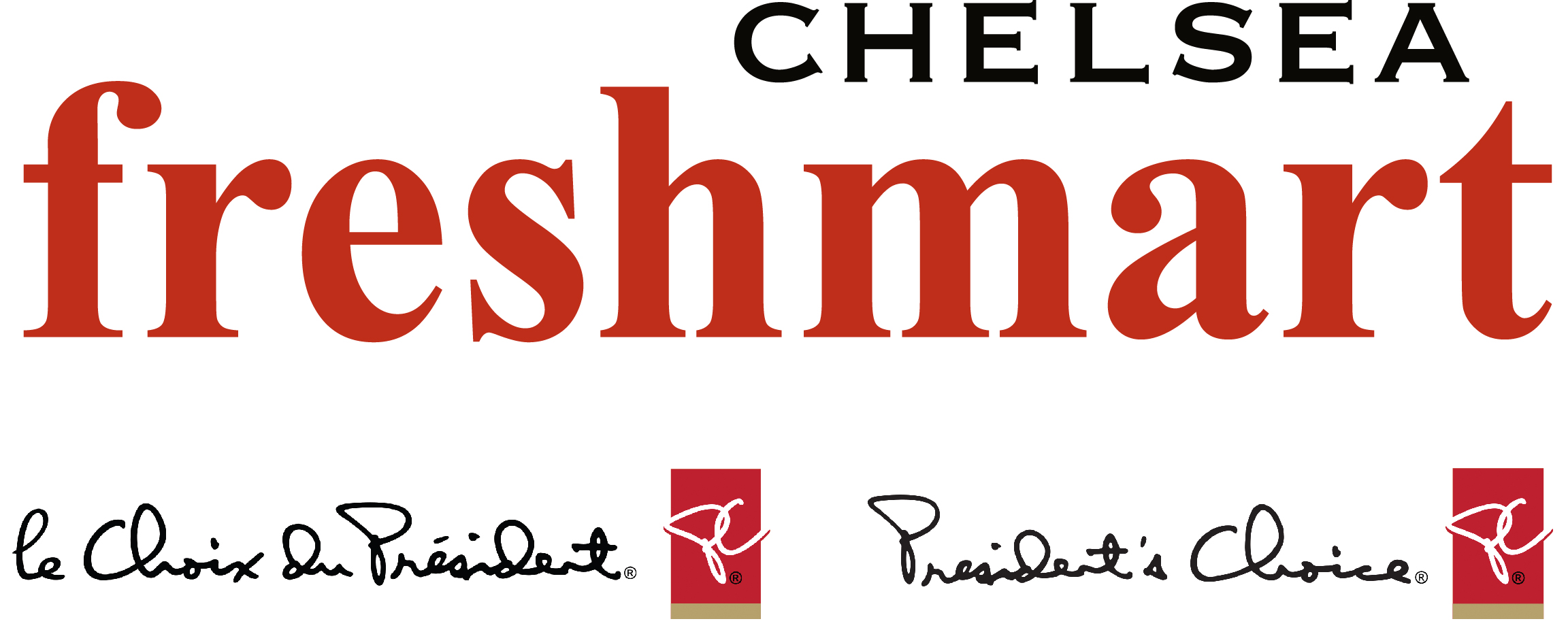




Supporters


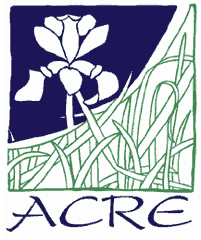
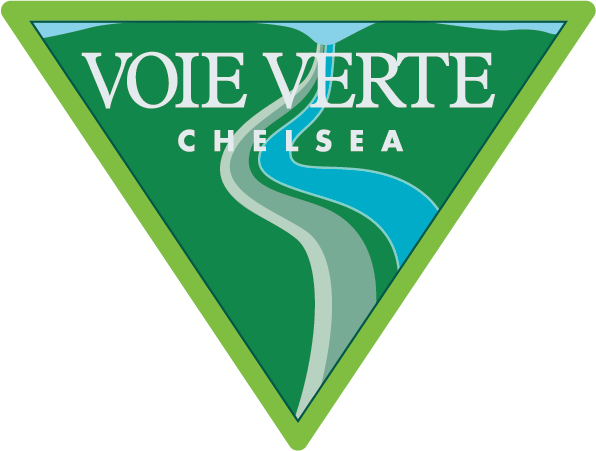
About Us
SCT is a community based, not-for-profit founded in October 2009 when a small working group of Chelsea citizens got together to look for ways to preserve what remains of Chelsea’s rich cultural and historical legacy of trails, and to enhance and expand the existing trail system. Officially established as a not-for-profit organization in August 2010, Sentiers Chelsea Trails has a constitution and a 12-person Board of Directors.
SCT has developed a strong volunteer workforce to build and maintain trail networks through planning. It works in close partnership with the Municipality who supplies building materials, tools, and signage for trail building, supports winter trail grooming and provides insurance for the trails. Voie Verte Chelsea (VVC) was created in 2017 as a fundraising arm to drive the campaign to generate revenue for the transformation of the rail corridor into a year-round trail.

